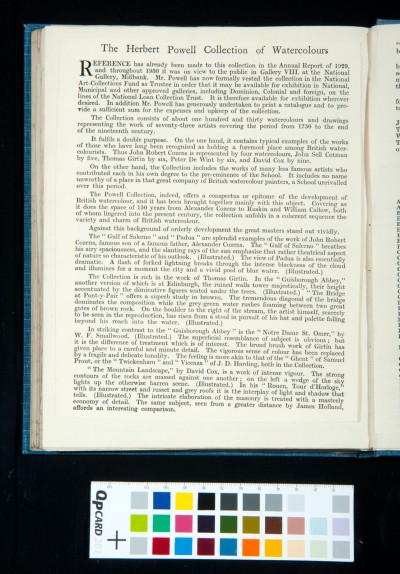Cotmania. Vol. VI. 1930-31
Archive: SDK Sydney Decimus Kitson Archive
Reference Number: SDK/1/2/1/6
Page:
-
Description
The Herbert Powell Collection of Watercolours
National Art Collection Fund Annual Volume 1931, The Herbert Powell Collection of Watercolours.
Date: 1930-31
-
Transcription
The Herbert Powell Collection of Watercolours
REFERENCE has already been made to this collection in the Annual Report of 1929,
and throughout 1930 it was on view to the public in Gallery VIII. at the National
Gallery, Millbank. Mr. Powell has now formally vested the collection in the National
Art-Collections Fund as Trustee in order that it may be available for exhibition in National,
Municipal and other approved galleries, including Dominion, Colonial and foreign, on the
lines of the National Loan Collection Trust. It is therefore available for exhibition wherever
desired. In addition Mr. Powell has generously undertaken to print a catalogue and to provide a sufficient sum for the expenses and upkeep of the collection.
The Collection consists of about one hundred and thirty watercolours and drawings
representing the work of seventy-three artists covering the period from 1750 to the end
of the nineteenth century.
It fulfils a double purpose. On the one hand, it contains typical examples of the works
of those who have long been recognised as holding a foremost place among British water-
colourists. Thus John Robert Cozens is represented by four watercolours, John Sell Cotman
by five, Thomas Girtin by six, Peter De Wint by six, and David Cox by nine.
On the other hand, the Collection includes the works of many less famous artists who
contributed each in his own degree to the pre-eminence of the School. It includes no name
unworthy of a place in that great company of British watercolour painters, a School unrivalled
over this period.
The Powell Collection, indeed, offers a conspectus or epitome of the development of
British watercolour, and it has been brought together mainly with this object. Covering as
it does the space of 150 years from Alexander Cozens to Ruskin and William Callow, both
of whom lingered into the present century, the collection unfolds in a coherent sequence the
variety and charm of British watercolour.
Against this background of orderly development the great masters stand out vividly.
The "Gulf of Salerno" and "Padua" arc splendid examples of the work of John Robert
Cozens, famous son of a famous father, Alexander Cozens. The "Gulf of Salerno" breathes
his airy spaciousness, and the slanting rays of the sun emphasise that rather theatrical aspect
of nature so characteristic of his outlook. (Illustrated.) The view of Padua is also essentially
dramatic. A Hash of forked lightning breaks through the intense blackness of the cloud
and illumines for a moment the city and a vivid pool of blue water. (Illustrated.)
The Collection is rich in the work of Thomas Girtin. In the "Guisborough Abbey,"
another version of which is at Edinburgh, the ruined walls tower majestically, their height
accentuated by the diminutive figures seated under the trees. (Illustrated.) "The Bridge
at Pont-y-Pair " offers a superb study in browns. The tremendous diagonal of the bridge
dominates the composition while the grey-green water rushes foaming between two great
gates of brown rock. On the boulder to the right of the stream, the artist himself, scarcely
to be seen in the reproduction, has risen from a stool in pursuit of his hat and palette falling
beyond his reach into the water. (Illustrated.)
In striking contrast to the "Guisborough Abbey " is the "Notre Dame St. Omer," by
VV. F. Smallwood. (Illustrated.) The superficial resemblance of subject is obvious; but
it is the difference of treatment which is of interest. The broad brush work of Girtin has
given place to a careful and minute detail. The vigorous sense of colour has been replaced
by a fragile and delicate tonality. The feeling is more akin to that of the "Ghent " of Samuel
Prout, or the "Twickenham " and "Vicenza " of J. D. Harding, both in the Collection.
" The Mountain Landscape," by David Cox, is a work of intense vigour. The strong
contours of the rocks are massed against one another ; on the left a wedge of the sky
lights up the otherwise barren scene. (Illustrated.) In his "Rouen, Tour d'Horloge,"
with its narrow street and russet and grey roofs it is the interplay of light and shadow that
tells. (Illustrated.) The intricate elaboration of the masonry is treated with a masterly
economy of detail. The same subject, seen from a greater distance by James Holland,
affords an interesting comparison.
